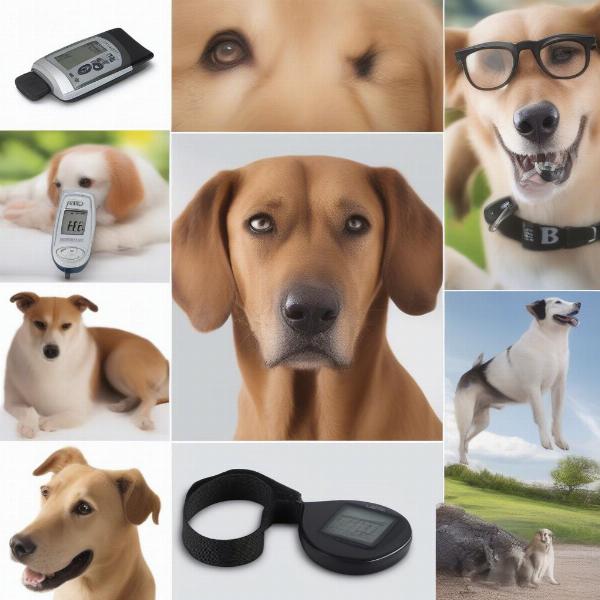Managing diabetes in dogs can be challenging, but with the right tools and knowledge, you can help your furry friend live a happy and healthy life. One essential tool for monitoring canine diabetes is a glucometer. This device allows you to measure your dog’s blood glucose levels at home, providing valuable insights into their condition and helping you adjust treatment as needed. This guide will cover everything you need to know about using a glucometer for dogs, from choosing the right device to interpreting the results.
Understanding the Need for a Glucometer in Dogs
If your dog has been diagnosed with diabetes, regular blood glucose monitoring is crucial for managing their condition effectively. A glucometer for dogs provides a convenient and relatively painless way to track blood sugar levels at home. This information is essential for determining the correct insulin dosage, adjusting diet, and recognizing potential complications early on. While regular vet visits are still necessary, home monitoring with a glucometer allows for more frequent and proactive management of your dog’s diabetes.
Choosing the Right Glucometer for Your Dog
 Various Glucometers for Dogs
Various Glucometers for Dogs
Not all glucometers are created equal. While human glucometers can sometimes be used, they are not always accurate for dogs and may require larger blood samples. Specifically designed glucometers for dogs often require smaller samples, minimizing discomfort for your pet. When choosing a glucometer, consider factors like ease of use, sample size, cost of test strips, and accuracy. Consult with your veterinarian to determine the best option for your dog’s specific needs.
How to Use a Glucometer on Your Dog
Using a glucometer on your dog might seem daunting at first, but with practice, it becomes a simple routine. The process generally involves pricking your dog’s earflap with a lancet to obtain a small blood sample, then applying the blood to a test strip inserted into the glucometer. The glucometer will then display the blood glucose reading. Be sure to follow the specific instructions provided with your chosen glucometer and consult your vet for guidance on the best sampling technique to minimize discomfort for your dog.
Interpreting the Results and Adjusting Treatment
Understanding the readings from your dog’s glucometer is crucial for effective diabetes management. Your veterinarian will help you establish target blood glucose ranges for your dog. Regular monitoring allows you to see how your dog’s blood sugar responds to insulin, diet, and exercise. This information can help you and your vet make necessary adjustments to their treatment plan and keep their diabetes under control.
Tips for Successful Glucometer Use in Dogs
- Positive Reinforcement: Reward your dog with treats and praise after each blood glucose test to make the experience more positive.
- Consistent Timing: Test your dog’s blood glucose at the same time each day to get consistent readings.
- Proper Storage: Store your glucometer and test strips according to the manufacturer’s instructions to ensure accuracy.
Conclusion
Using a glucometer for dogs is an important part of managing canine diabetes. By understanding how to use the device effectively and interpret the results, you can play a vital role in ensuring your furry friend’s health and well-being. Remember to consult with your veterinarian for guidance on choosing the right glucometer, establishing target blood glucose ranges, and adjusting treatment as needed.
FAQ
- Is it painful for dogs to have their blood glucose tested? The prick from the lancet is similar to a small pinprick and is generally well-tolerated by dogs, especially with positive reinforcement.
- How often should I check my dog’s blood glucose? Your veterinarian will recommend a testing schedule based on your dog’s individual needs.
- What should I do if my dog’s blood glucose is too high or too low? Contact your veterinarian immediately for advice.
- Can I use a human glucometer on my dog? While some human glucometers can be used, they may not be as accurate as those designed specifically for dogs. Consult with your vet.
- Where can I purchase a glucometer for my dog? Glucometers for dogs are available from your veterinarian or online pet supply stores.
- How do I clean the glucometer? Follow the manufacturer’s instructions for cleaning and disinfecting the device.
- Are there any alternative methods for monitoring blood glucose in dogs? While continuous glucose monitors (CGMs) are becoming available for veterinary use, they are not yet as widely used as glucometers. Discuss options with your vet.
About ILM Dog
ILM Dog (https://ilmdog.com) is your trusted resource for all things dog-related. We provide expert advice on dog breeds, health care, training, nutrition, grooming, and much more to help you provide the best possible care for your canine companion. From choosing the right products and accessories to understanding your dog’s health needs, we’re here to support you every step of the way. For expert advice and personalized support, contact us today at [email protected] or +44 20-3965-8624.